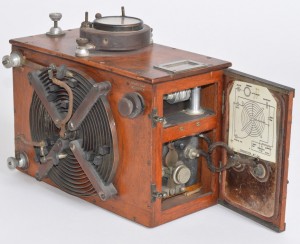
No. 1 Aircraft Transmitter Spark. 30-watt input. Note the spark gap on the top right inside the cabinet with the adjustment for the gap at the front.
February 1915
For once it was a bright day and the blue sky buzzed with aeroplanes, wheeling and climbing and dodging the shell-bursts as the guns sought to bring them down. It was fascinating to watch the white puff of an explosion appearing as if by magic against the blue of the sky, followed a moment later by the crack of the explosion and the whirr of the shell travelling through the air. They were British aeroplanes, and it was fortunate that the German shells failed to hit them because they were engaged on an important task. The first air cameras had just been delivered and the planes were taking advantage of the clear fog-free weather to photograph the German trenches and the fortifications behind their front line. These first aerial photographs would be flat affairs compared with the finely detailed shots that would later prove so invaluable, but they were infinitely better than nothing. The map-makers were working overtime and for the first time since the stalemate had set in the Army would have eyes, would be able to see beyond ridges and round corners, and the troops preparing for the coming battle would know precisely where they were going and what they would be up against.
There was another new innovation which the Army had been slow to accept. It was the idea that guns could be accurately ranged by aeroplanes observing their fire and sending back instant corrections by wireless, and it was the brainchild of Lieutenant Donald Lewis, a signals specialist of the Royal Engineers on secondment to the Royal Flying Corps. Had it depended on official channels it would never have got off the ground at all, but Donald Lewis had friends, and Lieutenant James, a fellow sapper, was equally enthusiastic. Together they installed a prototype wireless in Lewis’s aircraft and that was the easy bit. Neither officer was an expert in speedily sending Morse and it took them weeks to work up their speed and efficiency, Lewis in the air and James on the ground. Then they approached another friend, the commander of a 9.2 Howitzer battery, and invited him to join in the experiment. It was a startling success. An aircraft observing a shoot firing blind ‘by the map’ at a specified target could instantly signal back the result and the correction that would lay the gun accurately on the target. They had worked out a code using an imaginary clock face divided into segments superimposed on the map. It was simple and it was fool-proof. The War Office gave Lewis and James their blessing and sent them with their new system to France where they kicked their heels for a month before they were allowed to try it out.
Lt. D. S. Lewis, Royal Engineers, Att. RFC.
We went out with three machines, fitted with 300-watt Rouget sets, run off the crankshaft, and receiving sets with Brown relays. For a month they wouldn’t use us, having a very British distrust of things new! At last we got our chance and made about the biggest success of the war. We do nothing but range artillery, sending down the position of new targets and observing the shorts. The results are really magnificent. In this flat country all heavy artillery shooting is utterly blind without aeroplane observation. As it is, during a battle, every enemy battery that opens fire can be promptly dealt with and accurately ranged on. With ‘Mother’, the 9.2-inch ‘How’, one can generally hit a target with the first three shots. We signal the shots by a clock method, direction by figures, distances by letters, i.e. C9 means 200 yards at nine o’clock to the true north.
The problem was that in the run-up to the offensive there were precious few shells to spare, not even for the task of ensuring the accuracy of the guns in the all-important bombardment. But not all the guns had yet arrived and the Battery Commanders of those that were in place were none too keen to send precious rationed shells flying into the blue without good reason. Sir John French had calculated that by economising on ammunition he would store up enough for three days’ fighting. And a three-day fight would put him on top of the Aubers Ridge.
He was sure of it. It had to, it must succeed.